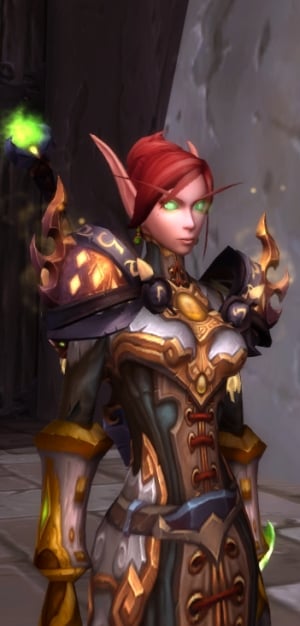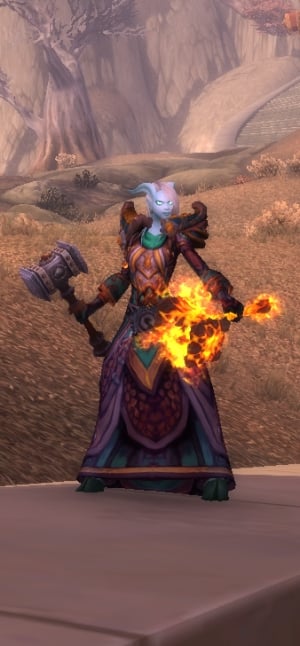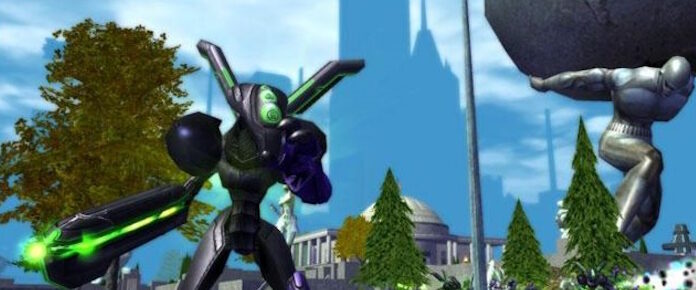
When last we left off, the world was screwed. World of Warcraft: Legion doesn’t tell you that you’re facing a huge threat, it just shows up, kicks in the door, ruins things around you, and then stands back and laugh. “Fight back, if you want to. Or don’t. You’re going to lose no matter what you do. We are the Legion, and we conquer everything.”
This is novel. In previous expansions, we’ve marched in to fix problems and confront a new threat; here, we’re marching in to confront an old threat only to have that threat knock us around and send us home as failures. We didn’t even get our foots in the door. No outposts established, no base of operations, just raw, crushing defeat. It’s clear, immediately, that we’re going to have to take a radically different approach to this war if we want to avoid extinction.
Thus do class orders and artifacts get into the mix. And the way that they’re handled is, again, at once novel and familiar, taking some of the best instincts of WoW‘s history and giving us something new.
 Class in WoW has always been more nebulous than it is in some other games. There are really only three classes with a single unified identity, and even then it’s somewhat muddled for Death Knights and Druids. Demon Hunters are a unified force, but usually your identity has much more to do with your nation and your faction than your class.
Class in WoW has always been more nebulous than it is in some other games. There are really only three classes with a single unified identity, and even then it’s somewhat muddled for Death Knights and Druids. Demon Hunters are a unified force, but usually your identity has much more to do with your nation and your faction than your class.
Of course, that’s also not true entirely. A lot of classes do have very strong identities within certain cultures. Tauren Sunwalkers are a unified order of a sort, ditto Blood Knights and Vindicators. Ravenholdt has long been a centralized locale for several different groups of Rogues, and the game’s Priests are part of the same religion for many races; Blood Elves, Undead, Humans, and Dwarves all heed the same tenets of the same faith. Overarching orders have always existed, just in the background.
The result is that bringing these things into the foreground feels like an evolution rather than a full-scale rewriting. There have always been bits and pieces of an order of Shaman, for example; what happens here is that all of them are coming together in one place, unifying, tying the cultures together into a single and augmented gathering. It’s an homage to the past without being shackled to it, something that creates a strong resonance but doesn’t have the sense of you simply signing on with an existing organization.
Mechanically, Order Halls have another purpose; they need to be Garrisons without being Garrisons. They need to have followers that don’t feel like followers and a reason to bring you back, but they also need to not… well, pull off the unenviable trick of Garrisons where it felt like your followers were having adventures rather than you. It’s a tricky balance.
It works, more or less. The key element was scope, I think. Your Order Hall is not someplace you need to check in on every half-hour, but a place to stop in on a regular basis when you’re finishing things up anyhow. If I’m already stopping back in Dalaran or first logging on, it’s a place to put my affairs in order before I head out, and its evolution feels very natural and straightforward. The slower timer (I have yet to see a mission beyond the introduction take less than two hours) and the emphasis on having more troops, on focusing more on an overarching campaign rather than just sending off individuals, makes the whole thing feel more like a management of your efforts in downtime.
It also helps that everything is much slower, and the emphasis is far more on “what do followers get for you” than “what cool new thing does this get your followers.” The missions ultimately feed back into my characters, not into their own self-contained system, and when I send a batch of followers out on a lengthy mission I know they’ll have something good.
Put more simply, managing Garrisons felt like running a Facebook city sim. This feels more like coming back to headquarters after a mission, checking in on what’s been done, and deciding our next priorities. It makes you feel like you’re in charge without constantly shouting for your attention. The slow set of upgrades and traits helps with this, too; it doesn’t feel functionally different from Garrison buildings except that you get more distinct and interesting choices along the way.
Of course, it’s impossible to separate Order Halls from Artifacts, but that’s also part of the point. Orders are class groupings that existed in various nascent forms beforehand, but now they’re pulling back together. Artifacts are weapons you may or may not have heard of, put in your hands to maximize their potential and fight back against the Legion. And they call back to the old days of talent trees while at the same time being different in their own right.
 Case in point: you’re never really choosing traits when you level your Artifact. Given time, you will get access to everything. That’s kind of the point. You’re choosing what to level first, not what you get as a given spec. It feels like a subtle shift, but it also means that the artifact avoids the problem that talent trees had of having certain “garbage” options. Everything is all upside, and you eventually will get it.
Case in point: you’re never really choosing traits when you level your Artifact. Given time, you will get access to everything. That’s kind of the point. You’re choosing what to level first, not what you get as a given spec. It feels like a subtle shift, but it also means that the artifact avoids the problem that talent trees had of having certain “garbage” options. Everything is all upside, and you eventually will get it.
The biggest problem I have with artifacts at this point is that they are the only real leveling mechanic in the expansion. Because of the way questing works, heading out at level 105 is identical to heading out at level 100; those five extra levels don’t mean anything specific. I would have much rather had the game simply count experience toward the artifact rather than toward the character, create a more meaningful sense of progression in that regard. As it stands, levels are pretty much empty.
It’s a bit of a failing, but it’s more of a quibble than anything; it doesn’t change the fact that artifacts themselves are pretty fun. The weapons bring back some memories of slotting gems with the various relics while also providing power increases that feel worthwhile and neat. And it appeals to me that the weapons are a hodgepodge of known weapons and stuff we’ve never heard of before; sure, these items might be legendary weapons, but that doesn’t mean we know about them ourselves. You are at once inheriting legends and forging new ones.
One of the things I said in my first part is that WoW‘s strength is usually its ability to show off something at once new and familiar, and this manages it. This pulls in inspirations from the game’s own past and its RTS roots, along with years of design in StarCraft II, to produce a very different feel of the expansion. In the past, we have, as players, been directed in our efforts to fix things. This time… we’re not. Our leaders are gone. And now we’re the leaders, directing the efforts, serving as the legends and the icons that the rest of the world looks up to. Sure, the game is still directing us, but in-universe we direct the path of our orders and the efforts we take to stop the Legion.
Of course, none of this would work if the act of playing the game or questing felt like a chore. So that’s what I’m going to discuss in my final piece on the expansion as a whole.
Did you miss part one of this series? Don’t forget to read back!













